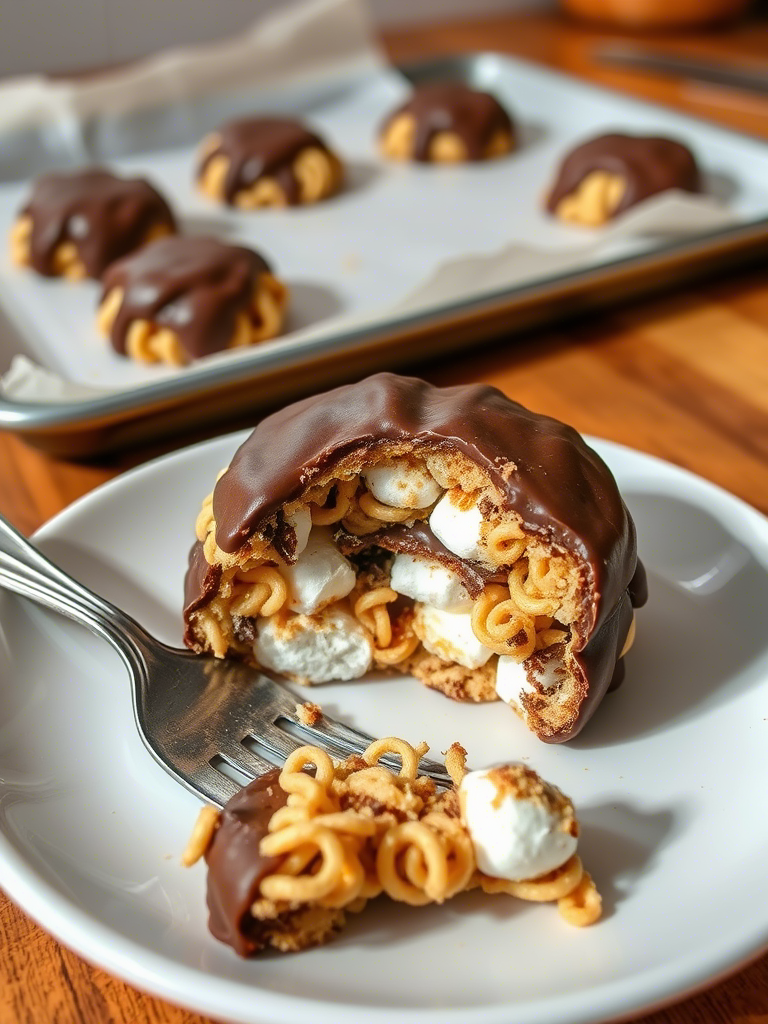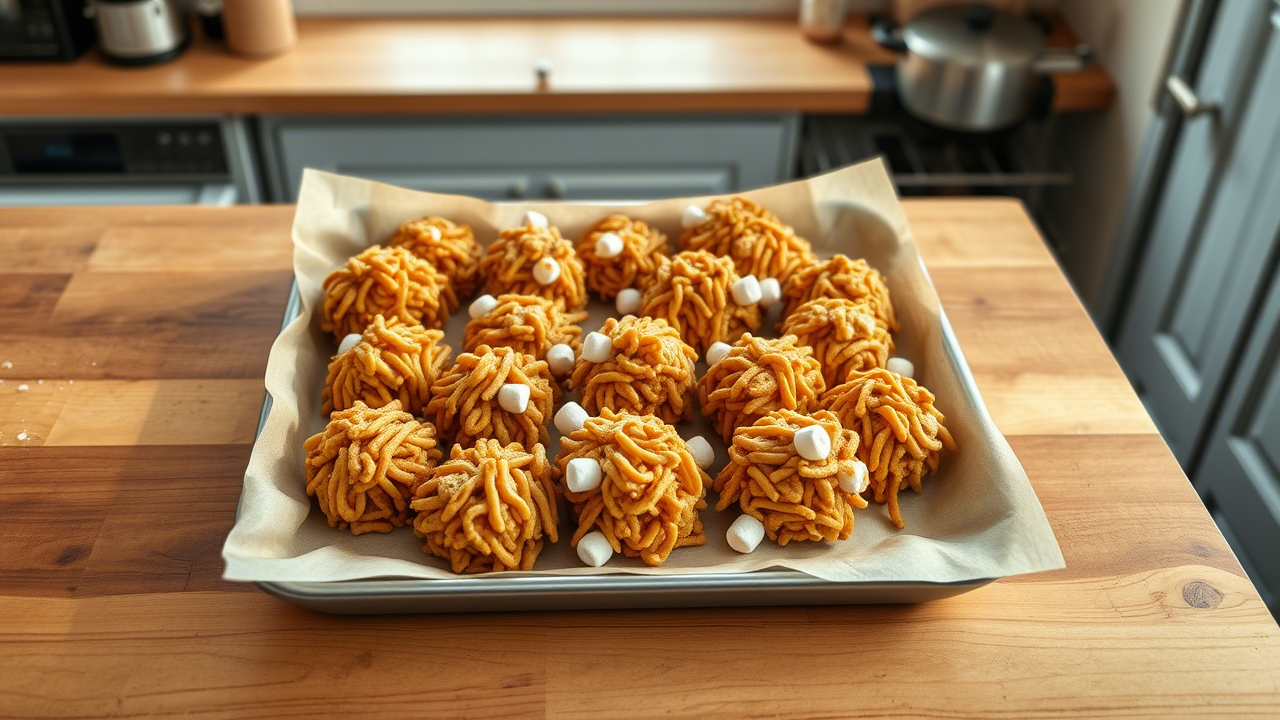They’re not fancy. They’re not fussy. But they always disappear first. No-bake haystack cookies are the kind of kitchen miracle you didn’t know you needed—until you’ve eaten six before they’ve even set.
Now, I’m not just talking about nostalgia on a plate. These crunchy, chocolatey, chewy, oddly delightful little stacks have earned a quiet cult following among pros who know their value. In catering kitchens, school fundraisers, high-volume bakeries, and home pantries—haystacks are quietly everywhere. And for good reason.
This article dives deep into why no-bake haystack cookies are more than just a retro recipe. We’ll explore the science, variations, professional applications, and how to get ‘em just right. This isn’t your grandma’s “dump and stir” write-up (though, bless her for the original). Let’s break it down with the eyes of a culinary expert—and the soul of a cookie fiend.
The Roots of the Haystack: More Than Just Chocolate and Crunch
First thing’s first: what are haystack cookies?
At their core, they’re a blend of chocolate (or butterscotch or peanut butter), some form of crunchy binder—usually chow mein noodles or oatmeal—and often a secondary fat like butter or coconut oil. No baking. No fancy mixers. Just melt, mix, drop, chill.
But don’t let the simplicity fool you.
Haystack cookies can be traced back to mid-20th-century American kitchens, popping up in community cookbooks and newspaper recipe columns. They were born out of wartime frugality and 1950s convenience cooking. You had pantry staples. You had ten minutes. You had dessert.
Yet even today, modern chefs and recipe developers are rediscovering these humble treats—and tweaking them with upscale ingredients and global flavor profiles.
Why Professional Kitchens Are Still Making Haystacks
Okay, so why do pros still care?
1. Cost-effective: The ingredients are cheap, shelf-stable, and incredibly forgiving. One batch can serve 30+ portions for under $10.
2. No oven required: In high-temperature kitchens—or places with zero baking equipment—these cookies are clutch.
3. Texture play: Haystacks offer that elusive snap-chew combo chefs chase after. You’ve got crisp noodles, creamy chocolate, sometimes a hit of sea salt or spice.
4. Customization: These cookies are a flavor playground. Swap out ingredients, layer spices, tweak sweeteners. It’s endless.
5. Nostalgia sells: People love foods that remind them of childhood. But elevate it with Maldon flakes or single-origin chocolate and you’ve got an artisanal upgrade.
So yeah, they’re easy. But they’re also strategic. Smart chefs keep them in their back pocket for a reason.

Key Ingredients That Make or Break a Haystack
Here’s where it gets technical. You can’t just melt a Hershey bar and dump it on noodles and call it a day. Well, you can—but don’t.
Chocolate: This is your flavor anchor. Semi-sweet chips are standard, but pros use couverture chocolate for smoother mouthfeel and glossy finish. Cocoa solids matter—look for 55–70% cacao for balance.
Binder: Classic haystacks use crispy chow mein noodles, which offer that dry crunch. Oats are softer and absorb moisture. Unsweetened coconut flakes, broken pretzels, puffed rice? All valid.
Fat: Butter, coconut oil, or even a neutral vegetable shortening can aid in setting and texture. Coconut oil gives a nice snap when chilled.
Add-ins: Peanut butter (smooth, not natural) helps emulsify and adds richness. Vanilla, espresso powder, chili flakes, sea salt, or citrus zest elevate without overpowering.
Now don’t go crazy. Balance is key. You want contrast—but harmony.
The Science Behind the Set: Why They Hold Without Baking
No-bake cookies rely on fat and sugar crystalization to hold their shape.
Here’s the deal: when chocolate cools, the cocoa butter solidifies into a crystalline structure. If tempered right (or melted gently), it gives a crisp bite and shiny finish.
Sugars like corn syrup or honey can also help stabilize the mixture and delay moisture absorption from the air (which is why haystacks don’t go soggy too quick).
The binder—like noodles or oats—gives structure and height. It’s not just filler. It holds the “haystack” form and resists collapse.
One misstep? If your fat-to-solid ratio’s off, you’ll either end up with oily puddles or crumbles that won’t stick.
Pro tip: Don’t overheat your chocolate. A double boiler or microwave in 15-second bursts saves many disasters.
Variations That Actually Work (and Sell)
Let’s get one thing straight—haystack cookies do not have to be brown, beige, and boring. Here are a few tested pro-approved variations that elevate the concept without killing the charm.
Mexican Mocha Haystacks
Dark chocolate + cayenne + cinnamon + espresso powder. Finish with a flake of sea salt. Serve with iced coffee.
Tahini White Chocolate Haystacks
Swap peanut butter for tahini. Use white chocolate, unsweetened coconut, and roasted sesame seeds. Unexpected and deeply addictive.
PB&J Haystacks
Peanut butter base + freeze-dried strawberries crumbled in. Top with a dot of strawberry jam before chilling.
S’mores Haystacks
Mix in mini marshmallows, crushed graham crackers, and milk chocolate. Hit that nostalgia button hard.
Vegan + GF Haystacks
Use dark vegan chocolate, gluten-free oats, and coconut oil. Toss in pumpkin seeds and dried cherries. Clean-label dream.
Get creative, but test in small batches. Flavor balance shifts fast when you’re not baking things down.
Storage, Shelf Life, and Commercial Considerations
In a commercial environment, storage and transportability are critical.
Shelf life: Up to 7–10 days in airtight containers at room temp. Extend that to 2 weeks refrigerated. They do not freeze well; the noodles or oats get rubbery.
Packaging: Use parchment liners if stacking. Cellophane bags with twist ties look cute and practical. Just keep ‘em away from heat.
Scaling: Because there’s no rising agent, you can scale this recipe in huge batches with minimal variability. Just keep chocolate ratios consistent and stir like you mean it.
Labeling: For sale, be mindful of allergens. Nuts, dairy, and gluten abound in most versions. And FDA guidelines require accurate labeling on confections.

Common Mistakes Even Smart People Make
1. Overheating the chocolate.
Scorched chocolate gets grainy and bitter. Use gentle heat, stir often, and skip the boiling water bath.
2. Using natural peanut butter.
It separates. It’s oily. It makes the cookie cry. Use good ol’ Jif or Skippy. Not sorry.
3. Skimping on salt.
A tiny pinch of kosher salt in the mix makes the whole thing pop. Without it, it’s flat and too sweet.
4. Not working fast enough.
Once mixed, drop the stacks quickly. The chocolate sets fast. You’ll end up chiseling chunks out of your bowl.
5. Under-mixing.
Dry clumps of chow mein noodles aren’t fun to chew. Mix thoroughly, but gently. Coating every piece is crucial.
What the Data Says: Cookie Trends & Consumer Cravings
According to a 2024 trend report by Innova Market Insights, 71% of consumers said they actively seek “simpler, nostalgic” desserts with recognizable ingredients. No-bake cookies hit that mark.
Sales data from small-batch bakeries show a 20% increase in no-bake confections during warmer months. People don’t want hot ovens. They want quick, satisfying sweet fixes that won’t melt before dinner.
Google Trends also shows steady interest in “no-bake cookies,” spiking seasonally—especially during holidays and back-to-school periods.
Translation? Haystacks are having a quiet resurgence. And smart businesses are catching on.
Are Haystack Cookies “Real” Enough for a Pastry Menu?
Some chefs might scoff—haystacks don’t require skill, right?
Wrong.
The skill is in restraint. Knowing when to tweak and when to leave it be. Understanding texture. Playing with flavor. Respecting nostalgia while offering something new.
A no-bake cookie that gets someone to say, “Wait…what is this?!”—that’s the goal.
Put a tahini haystack on a slate board with matcha panna cotta and a scoop of yuzu gelato. Suddenly, it’s modern pastry. Contrast is king.
Final Crumbs: Mastering the Humble Haystack
No-bake haystack cookies are more than a last-minute bake sale fix.
They’re a masterclass in efficient confection. They show that simple doesn’t mean lazy. That familiar can still surprise. That a dessert without flour, eggs, or an oven can still make people smile like idiots.
In the hands of a creative cook, a haystack becomes a blank canvas. In the hands of a professional, it’s a low-cost, high-impact treat that punches above its weight.
So next time someone calls them old-fashioned—make a batch. Serve one warm. With a little chili salt. And watch their face change.
There. You’ve converted another one.
And isn’t that what great cooking’s about?
FAQs
What are no-bake haystack cookies made of?
They’re typically made with melted chocolate, chow mein noodles or oats, and mix-ins like peanut butter or coconut.
Do haystack cookies need to be refrigerated?
Not necessarily—store them at room temp for 7–10 days or refrigerate to extend freshness.
Can I use natural peanut butter in haystacks?
Nope, it separates and ruins the texture—stick with processed creamy peanut butter.
Are haystack cookies gluten-free?
Only if you use gluten-free oats or noodles—always check your ingredients.
How long do haystack cookies take to set?
Usually about 30–60 minutes in the fridge or 2 hours at room temperature.
Can I freeze haystack cookies?
It’s not ideal—the texture suffers and noodles go weirdly chewy.
What’s the best chocolate to use?
Couverture or high-quality semi-sweet chocolate gives the best taste and snap.
Can I scale this recipe for a bake sale or cafe?
Yes, it scales super well—just keep ingredient ratios consistent.
Are haystack cookies still popular today?
Yep, they’re trending with nostalgic flavors and easy prep—especially in summer.
How do I keep my haystacks from crumbling?
Make sure everything is well coated and don’t skip the fat like butter or coconut oil.

Mariana is a passionate home cook who creates delicious, easy-to-follow recipes for busy people. From energizing breakfasts to satisfying dinners and indulgent desserts, her dishes are designed to fuel both your body and hustle.
When she’s not in the kitchen, she’s exploring new flavors and dreaming up her next recipe to share with the Foodie Hustle community.

